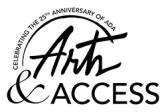Posted on by lvartscouncil By Robert Sandoval, LVAC Volunteer
In my research to develop this blog post on the healing power of the arts, I interviewed two engaging local artists, Middle-eastern dancer Tahya, and painter Marion Sheinberg, both of whom provide joy and solace to their clients.
Tahya, whose name means “welcome” has been dancing since her teens and is now a “leading authority” on dances throughout the Middle and Far East. “I went from being a very shy, reserved person to evolving into a woman who is more than happy to be outgoing and sharing my enthusiasm with other people. So the dance provided that for me.” Tahya has taught many women and men the movements and ancient techniques which transport them to a mindset where modern day stresses fades away by letting go of the mind. The dance’s therapeutic value allows your mind to become clear and one with the music.
“The arts; and, I believe, dance in particular which utilizes the body as the instrument of art; encourages vision, hope and imagination – all of which foster relaxation as well as a pathway to the healing process. The arts enable us to discover the magic in our creative potential and manifest it to the fullest potential” – Tahya.

“I paint so my days are great” says local water-colorist Marion Sheinberg, who finds consolation in the art that she produces, believing that “Painting is therapy for myself.” Marion has been painting for five years and has always loved art. After she retired she attended local art classes at the Banana Factory and the Baum School of the Arts. “Art has been an outlet and helps other people too; they love the painting that I do for them.” Marion painted Dutch, a therapy dog that has touched the lives of many patients in Allentown’s the 17th and Chew Hospice. They were so impressed with her work that they decided to hang Dutch’s portrait in the entrance. However, this isn’t the first time that her clients have thanked her; most find it therapeutic to see their deceased pet’s memory cherished in a portrait. At a comfortable pace, the average watercolor portrait takes about two to three weeks’ time to complete. Marion prides herself on the pet’s eyes in her photo-realistic work claiming that the eyes are the doorways to the pet’s personality.
“You see so much with the eyes, and I devote a lot of time and detail to the eyes of my painting. And once I capture that my clients say ‘I can’t believe how much of that looks just like my dog.’” – Marion Sheinberg
Also, I stumbled across a very moving video entitled The Science of Happiness – Art Therapy which posits the question—can art therapy make people happy? Several subjects were asked to associate things that make them happy with a certain color. After tracing an outline of their bodies on a large canvass, the fun began—the outlined silhouettes became an empty canvass for them to create their painted masterpiece using the predefined colors. Each subject had their own ways of expressing themselves and the final artwork on each canvass was very different—some were very quiet and organized while others very brassy and explosive. One thing that they all had in common were the fact that each artwork showed a story; an insight of into the person. The art therapist analyzed the finished masterpieces and inquired about certain choices in color and techniques which caused the subjects to open up about personal experiences and people who have touched them deeply. Art was a window to their psyche that allowed them to express their inner most feelings. At the end of the experience an increase in happiness was noted among the subjects. Whether we are disabled from age, thoughts, or inability to say how we feel; art has always been a great medium to open ourselves up.
As the famous artist Pablo Picasso once said, “art washes away from the soul the dust of everyday life.”
The Lehigh Valley Arts Council is currently engaged with the Lehigh Valley Partnership for a Disability Friendly Community in planning the 25th anniversary celebration of the Americans with Disabilities Act through the lens of the arts, commencing July 26, 2015.
- For more information on Tahya visit: www.Tahya.com
- Marion Sheinberg can be contacted at: LMSheinberg@aol.com
- For more information on LV Arts Council’s Arts & Access program: www.LVArtsCouncil.org/Access/



